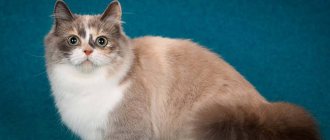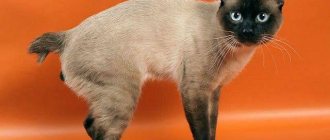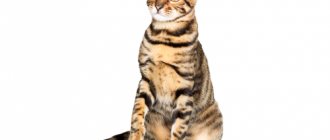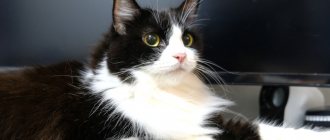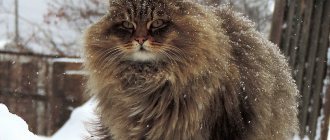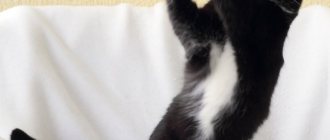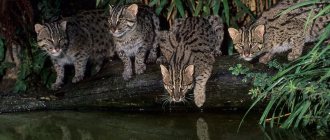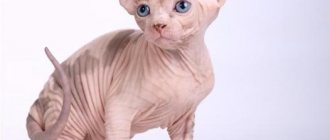The Munchkin is a cat breed that has fans all over the world. The short legs and cute faces of animals with a childish expression evoke tenderness and delight. You want to touch the delicate thick fur.
They occurred due to a mutation, but do not suffer at all, being healthy, active, and agile. More and more people want to buy a munchkin, the reviews about them are only positive.
If you want to get a munchkin, this description of the breed will help you get acquainted with its size, color, character traits, rules of care and feeding, and cost.
The history of munchkins
Munchkins are charming short-legged cats.
In the 30s of the twentieth century, references to unusual short-legged cats periodically appeared in Europe. The Second World War, which soon broke out, almost completely erased this genetic line. In 1944, one of the British veterinarians reported observations of several generations of cats that were similar to ordinary domestic cats except for the parameters of the limbs. After the war, such animals were seen in the USA and USSR. In 1953, Soviet sources dubbed them "Stalingrad kangaroos", suggesting that the mutation occurred due to existence in harsh conditions.
The modern round of development of the Munchkin breed occurred in 1983, when teacher Sandra Hochenedel from Louisiana, returning home, noticed an unusual pregnant cat. The woman took pity on her and took her in, giving her the nickname Blackberry. Half of the kittens that were born also had short legs, which surprised Sandra. She decided to give an unusual pet to her friend Kay LaFrance. This is how the Blackbury and Toulouse cats became the ancestors of the modern breed.
Sandra and Kay managed to interest Dr. Solveig Pflueger, who served as a TICA judge, about munchkins. He examined the unusual cats and made an unequivocal verdict - the breed appeared naturally, thanks to changes in the recessive gene that regulates the length of the paws. Unlike dachshunds and other short animals, munchkins' short legs usually do not lead to back problems.
Munchkin kitten
The general public first learned about the breed at the TICA national show held at Madison Square Garden in 1991. Most viewers and experts were critical of the viability of munchkins, branding them living evidence of violations of the breeders' ethics. Despite lengthy disputes, by 1994 TICA managed to list the breed as developing. In the early 2000s, munchkins won the championship title and gained real popularity.
The breed is recognized by the associations TICA, AACE, UFO, SACC and WNCA. The FIF, CFA and Governing Council of the Cat Fancy societies refused to register munchkins, considering these cats to be genetically inferior. TICA resolved the issue democratically - only cats whose owners are able to confirm a monobreed pedigree in three or more generations are allowed to participate in the show. Munchkins got their unusual name in honor of the cheerful, friendly people from the book “The Wonderful Wizard of Oz.”
History of the origin of the breed
Munchkins were born as a result of random mutation processes, so the appearance of this breed has nothing to do with the efforts of breeders. This happened somewhere at the beginning of the last century.
Interesting to know! The peculiarity of this animal is associated with its original appearance, due to the presence of the achondroplasin gene in the Munchkin genes.
After the appearance of this breed, the whole of Europe vigorously discussed this fact, indicating the appearance of an unusual cat with very short limbs. The breed appeared on our territory not so long ago, about a decade and a half ago, but managed to gain the trust of many breeders.
Munchkin appearance
Munchkin
Munchkins are unique and cannot be confused with other cats due to their greatly shortened paws. With an average body size, the legs of these cats are 2-3 times smaller than those of other breeds. Despite this mutation, munchkins have retained a healthy spine, so they have a mobile, flexible, strong body. The average weight of cats ranges from 2.2 to 4 kilograms.
Munchkins are often crossed with other breeds, so they can differ in appearance and personality. The offspring are often long-legged. Such cats do not participate in shows, but can be used for the development of the breed, since the presence of two short-legged parents increases the mortality rate of kittens in the litter. Breeders are actively developing munchkins, so associations have not yet introduced strict standards.
Head
Proportional to the size of the body, has rounded contours, the shape of a modified wedge. The cheekbones are high and are usually more pronounced in cats than in cats. The muzzle is of medium length, the transition of the nose to the forehead is smooth. Some deflection of the bridge of the nose is allowed. The chin is small and firm.
Eyes
Munchkin looks out the window
Almond-shaped, medium to large in size. The rather wide set at a slight angle provides an open expression to the muzzle. Munchkins do not have a strict connection between eye color and coat color.
Ears
The ears are wide at the base and rounded at the tips. Sinks can be medium or large in size, located wide and high. The presence of tassels is permissible only in representatives of the breed with long hair.
Neck
Cats have larger, more muscular, dense necks than cats.
Body
The Munchkin's body is elongated and cannot be called compact. The back has a slight downward slope from the tail to the shoulders. The hips are firm, the chest is rounded. The bones are of medium size, the muscles are well developed. Males are usually larger than cats. Angled blades are allowed.
Munchkin and his toys
Legs
The limbs are short, located at the same distance in the direction of view from head to tail. The upper and lower parts of the front legs, as well as the thighs and lower parts of the hind legs, are equal in length. The hind limbs are often slightly longer than the forelimbs. Munchkins have three legs: regular, short, and very short (Rug hugger).
Paws
Red munchkin kitten
The Munchkin's paws are proportional to the body and have a rounded shape. Curvature outward or inward is not allowed.
Tail
The length of the tail and body is usually the same. The thickness is average, there is a rounded, somewhat narrowed tip. During movement, the tail comes to a vertical position. If there is long hair, this part of the body receives an abundant plume.
Wool
The coat is silky semi-long or velvety short, with medium undercoat.
Colors
Munchkins can have any coat color; bicolored individuals are often found.
Lifespan
Munchkins live 12-13 years, but with professional care they can live up to 16-20 years.
Possible disadvantages
Too short or long nose, protruding chest bone, round head and eyes, cow-type paws, stocky short body, curly hair.
Disqualification criteria
Deafness, amputated claws, cryptorchidism.
Disqualifying defects for exhibition
The presence of characteristic features of other breeds, saggy croup, excessively concave back.
Nutrition
The number of meals depends on the age of the pet:
- up to four weeks - five times a day;
- from twelve weeks to one year - three or four times;
- adults - twice.
Up to four months it is necessary to give porridge, meat, and fermented milk products. The diet of adults includes vegetables and fish fillets.
Premium dry and wet food and holistic foods are recommended.
Required products on the menu:
- unsweetened fermented milk products without dyes and synthetic thickeners;
- dietary meat;
- sea fish;
- cereals, excluding legumes;
- vegetables, except potatoes;
- chicken and quail yolks;
- meat by-products (for example, liver).
Fish and meat should be boiled and mixed into porridge. Vegetables are not fully digestible by animals. This must be taken into account when creating a menu.
Photos of munchkins
Minskin
Unusual cats with short legs resemble sphinxes in their lack of fur. Not surprising, since Sphynxes, as well as Munchkins, Devon Rexes and Burmese, are the ancestors of the breed. Minskins have small patches of fur on the face, tips of the paws, tail and sparse hairs on the body. This breed of short-legged cats is also called “hobbits.”
Pets are curious by nature and love to climb onto high surfaces. Minskins often get along with dogs and become their true friends.
Munchkin character
Munchkin on his hind legs
Munchkin looks at life realistically and does not complain about its trials, is confident in himself and his abilities, good-natured, and curious. People see these cats as slightly out of this world. It cannot be said that the character of munchkins is approximately the same, it depends on genes, so their types of behavior are different. But in general, these are lively animals with great sympathy for people.
Representatives of the breed love outdoor games; the short legs of munchkins do not prevent them from being quite nimble: they very quickly jump on low tables, chairs, and other furniture. And the owners’ favorite curtains are also easily attacked by them. Of course, they won’t be able to jump too high, but stealing something tasty from the kitchen table after first jumping on, for example, a stool is a piece of cake for them.
Munchkins are smart, very friendly, clean animals that quickly get used to new surroundings and people. They remain playful throughout their lives and are especially fond of children. Munchkins are extremely inquisitive, often “borrowing” and hiding small things to play with in moments of loneliness, so it is better to hide all valuable, fragile trinkets away. It is advisable to periodically look for such “treasuries”, since missing keys, socks, and pencils are usually found there.
Munchkins are distinguished by truly canine devotion to their owner, but they have their own character and are able to stand up for themselves. These cats easily tolerate travel and do not resist walks on a harness. An interesting feature of the breed is the ability to sit on its hind legs for a long time, surveying the surroundings. At the same time, the front legs hang funny along the body, which is why munchkins are often called “kangaroo cats.”
Conclusions about the munchkin cat breed
The original and funny munchkin cat breed is becoming more popular all over the world for many reasons:
- the touching expression of the face and the small size of the cat evoke a desire to take care of such a treasure;
- short legs do not make the animal clumsy; on the contrary, agility and speed of movement will be the main characteristics of mobility;
- numerous color variations will suit every taste;
- the kangaroo cat is very playful and loves to take part in outdoor games;
- a peaceful disposition will be appreciated by people with small children in the house;
- not a loud animal at all: no annoying meows at night;
- The health of a purebred kitten and care for it guarantee the absence of serious problems in the future.
The owners of these animals can be considered happy people.
Care and maintenance
Who is the most curious cat?
This breed is easy to maintain and does not require special care. Experts recommend following a few simple rules.
- Despite the sociable nature of cats, they love to “build nests” in order to feel protected while resting. Provide the munchkin with a basket, small sturdy box, or other house with soft bedding.
- Buy a deep tray, since clean pets actively bury waste and can litter around.
- It is enough to comb short-haired munchkins once a week, and 2 times a week for long-haired munchkins. The main thing is to prevent tangles from occurring.
- It is enough to bathe these cats once every 3-4 months with special shampoos.
- Changing claws is usually easy for munchkins, especially if there is a scratching post in the house. Once every 2-3 weeks it is worth checking the condition of the paws in order to help the pet if necessary.
- You should clean your ears not deeply and very carefully, about once a month.
- It is not advisable to let cats go for walks on their own, as a squat animal often looks like it is preparing to attack, which may be misunderstood by other pets or people. Due to the short legs, the munchkin can be injured.
- Munchkins should be fed in moderation because, despite their high mobility, they are prone to obesity. Provide frequent replacement of drinking water and adequate nutrition.
- By using special toothpastes once a month, you can successfully prevent the development of oral diseases in munchkins.
Om-Nom-nom
As for food, it is not recommended to feed your cat from a common table. Use specialized or separately prepared natural foods. These types of food should be alternated, but not mixed in one plate. Do not buy cheap food as it is similar to fast food for humans. Are you planning to cook food for your munchkin at home? Experts advise preparing your diet this way:
- 60% – raw or boiled meat (rabbit, beef, offal);
- 30% – boiled or raw vegetables;
- 10% – porridge.
Munchkins should not be treated to salty, sweet, fried, smoked, bean dishes, fish, or fatty meats (lamb, pork). An adult cat can be fed a couple of times a day, kittens - up to 6 times a day.
Skokum
Country of origin:
USA
Height:
15 cm
Weight:
1.5–3.2 kg
Age:
12–16 years old
Skokum is a dwarf cat breed with curly hair. She appeared as a result of crossing a Munchkin and a Laperm. Currently considered experimental. It is believed that this breed of cat has the shortest paws - Skokums are very miniature. The color of such animals can be any, and the fur is always curly, especially on the collar.
The character is characterized by good nature. Skokums are not only cute on the outside, but also on the inside. They are playful and good-natured. They become attached to the owner quickly and for a long time.
They are very curious and eager to explore the territory. That is why the owner should hide his things in hard-to-reach places. Otherwise the cat may ruin them. Despite their short legs, skokums can jump onto chairs and sofas. They love to run around the house. They meow very rarely.
They do not require special care. Your pet's fur should only be washed when it gets dirty. To keep it fluffy and healthy, it needs to be sprinkled with plain water from time to time. The curly collar must be combed regularly with a special brush.
Munchkin health
Two Friends
The Munchkin is a young breed with an actively expanding gene pool, so its representatives rarely suffer from congenital diseases and have good immunity. Owners should know that such cats have some intolerance to plant foods, so their share in the diet should be small. Sometimes there are cases of congenital lordosis - excessive deflection of the spine in the area of the shoulder blades.
Munchkins may suffer from lordosis. This is a disease in which the muscles that support the spinal column are weakened and it moves into the chest cavity, putting pressure on the heart and lungs. A slight curvature will not cause problems, but it can be aggravated by previous injuries and obesity. Severe lordosis causes difficulty breathing and increases stress on the heart muscle, which can lead to illness. However, lordosis is a fairly rare disease. By the way, other cat breeds can also suffer from it.
Since the munchkin's short paws are a consequence of a natural genetic mutation, some kittens may have short paws, while others may have normal or long paws. If the gene responsible for short limbs is passed on to an embryo from both parents, it can be fatal.
Veterinary
All the many advantages of munchkins - both their external charm and wonderful character - fade into the background if the animal is unhealthy. It is important not only to choose the right pet for yourself that is strong and disease-resistant, but also to constantly maintain it in optimal physical shape. And here a lot depends on the owner - on proper maintenance of the cat at home and qualified veterinary care.
Breed defects and diseases
Munchkins who lead a sedentary lifestyle are at risk. At the same time, against the background of regular overeating, such an unpleasant and dangerous disease as lordosis can develop. Burdened with excessive loads, the spine bends beyond measure, internal organs are subjected to pressure and even deformation. To avoid pathology, you just need to promptly provide the animal with a normal diet and physical activity, and also visit a veterinarian from time to time for preventive examinations.
Pay close attention to your pet's posture
How to choose a kitten
The rules for selecting munchkin kittens are standard: take active, clean babies aged 12 weeks or older with the necessary vaccinations. Contact only reputable kennels that offer registered animals. This will allow you to purchase a truly healthy kitten, without serious congenital defects. Munchkins have won the love of a wide audience, so real queues often line up for them. If you don’t care about a certain gender, color type, or coat length, you can get a kitten fairly quickly. You should not buy munchkins at bird markets or through private advertisements, tempted by the low price. This can result in long-term treatment of the animal or the acquisition of a non-viable individual.
Buying a kitten
Munchkins were and remain a rare breed - kittens are expensive, especially if they are of interest for exhibitions and breeding work. The cost of a breed- or show-class animal starts at a thousand dollars, but a breed defect, of which there are many, can be purchased much cheaper. Therefore, when thinking about this particular breed, you should objectively weigh your ambitions and capabilities, decide: do you want a cute baby just for fun or do you intend to seriously engage in breed activities.
Photos of munchkin kittens
How much does a munchkin cost?
The price of a Munchkin kitten in Russia ranges from 3 to 40 thousand rubles, depending on gender, color, coat length, and the specific breeder. It is customary to cross Munchkins only with healthy domestic cats of similar appearance or with each other. Hybrid kittens that have inherited characteristics of other breeds are not allowed to show and are therefore sold at a reduced price. They do not differ in character from their counterparts and sometimes look nicer than the show ones. Also, healthy pets with other appearance features that cause disqualification from competitions will cost less. This is a great opportunity to acquire a loyal four-legged friend inexpensively.
Cat sizes and weights
The Munchkin cat with short legs is not large in size. Body length is average. The height of the animals' withers is approximately 15 cm. Kittens quickly increase in size.
Weight depends on gender. The weight of a cat is 3-4 kg, a female cat is 2-4 kg. The size of munchkins also depends on the species. There are cats that are larger than the standard parameters, and there are cats that are smaller.
A Munchkin cat with short legs is not large in size/Yandex Collections
